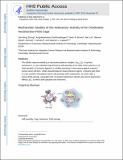Mechanistic studies of the anticancer activity of an octahedral hexanuclear Pt(II) cage
Author(s)
Zheng, Yaorong; Suntharalingam, Kogularamanan; Bruno, Peter Michael; Lin, Wei; Wang, Weixue; Hemann, Michael; Lippard, Stephen J.; ... Show more Show less
DownloadHemann_Mechanistic studies.pdf (791.0Kb)
PUBLISHER_CC
Publisher with Creative Commons License
Creative Commons Attribution
Terms of use
Metadata
Show full item recordAbstract
The cellular response evoked by a hexanuclear platinum complex, Pt6L4(1), is reported. Compound 1, a 3-nm octahedral cage formed by self-assembly of six Pt(II) centers and four 2,4,6-tris(4-pyridyl)-1,3,5-triazine ligands (L), exhibits promising in vitro potency against a panel of human cancer cell lines. Unlike classical platinum-based anticancer agents, 1 interacts with DNA in a non-covalent, intercalative manner and promotes DNA condensation. In cancer cells, 1 induces DNA damage, upregulates p53, its phosphorylated form phospho-p53 and its downstream effector, p21, as well as both apoptosis and senescence. Keywords: Self-assembly; Cage; Anticancer; DNA damage
Date issued
2016-03Department
Massachusetts Institute of Technology. Department of Chemistry; Koch Institute for Integrative Cancer Research at MITJournal
Inorganica Chimica Acta
Publisher
Elsevier
Citation
Zheng, Yao-Rong et al. “Mechanistic Studies of the Anticancer Activity of an Octahedral Hexanuclear Pt(II) Cage.” Inorganica Chimica Acta 452 (October 2016): 125–129 © 2016 Elsevier B.V.
Version: Author's final manuscript
ISSN
0020-1693